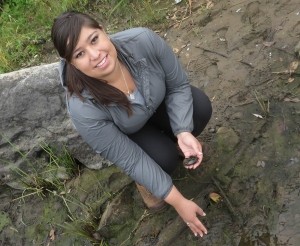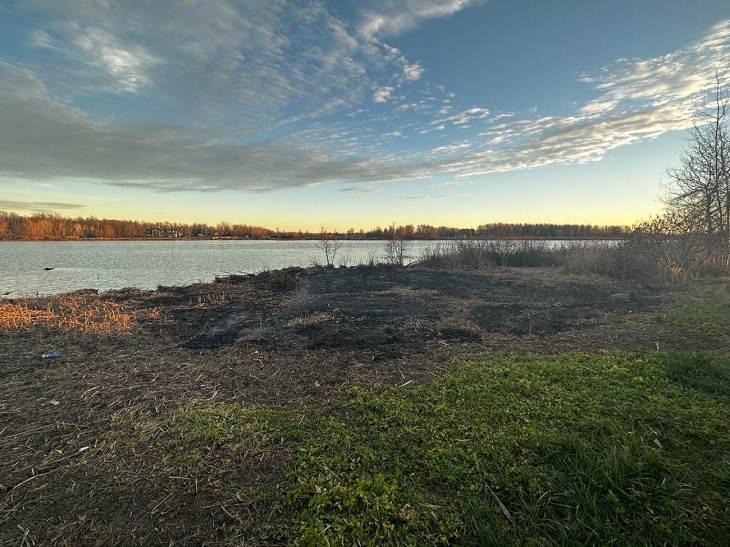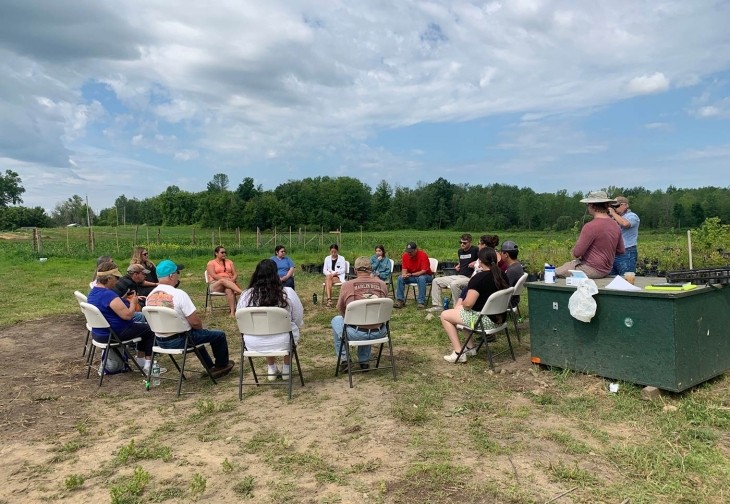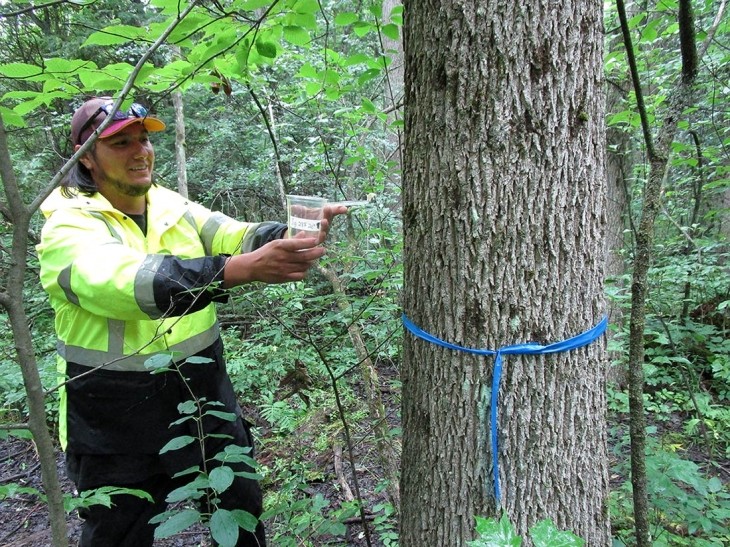A member of the Saint Regis Mohawk Tribe, Jessica Raspitha started working with the tribe’s Environment Division as an intern during her college years, and has been a full-time employee since 2014, currently serving as the program manager for the division’s Land Resources Program. Jessica’s work has included promoting Integrated Pest Management practices, helping to start the Saint Regis Mohawk Tribe Native Plant Nursery, and working on strategies to battle emerald ash borer infestations, which threaten not only the forest ecology in Akwesasne, but the cultural practice of basket making as well.
I grew up in Akwesasne, one of the recognized Mohawk territories along the St. Lawrence River and the U.S.-Canadian border. More specifically, Akwesasne is located at the confluence of the Grasse, Raquette, St. Regis, and Salmon rivers with the St. Lawrence River. I was very fortunate during my childhood to always be near or on the water. One of my favorite places is on the St. Lawrence River behind my grandparents’ house. I have a lot of cousins, and we spent our entire childhood down by the river – swimming and hunting for minnows and digging up mussels and playing volleyball.
I went to Dartmouth College, and when I got there, I didn’t know what I wanted to study. I spent a lot of time in different departments. I did biology. I did chemistry, music, history, political science. I was all over the place. When I took my first environmental studies course at the beginning of my sophomore year, that’s the one that felt like it fit the best. I think I liked it because the environmental studies coursework is so interdisciplinary and incorporates many aspects from other departments. There’s a large science and math component, but there’s also a legal component, and there’s a really strong anthropological and societal component to it.
The Environment Division is part of the Saint Regis Mohawk Tribe, which is the elected governing body in the southern portion of Akwesasne. The Environment Division started in the 1970s and has grown to be one of largest environmental programs in Indian Country. Our division comprises six different programs. We have the Transfer Station, which handles solid waste and recycling. The Agriculture Program not only supports local growers, but also produces and markets eggs and pork products. We have an Air Quality Program working to improve and monitor both the indoor and outdoor air quality. There’s the Water Resources Program, which monitors our water and our fish for contaminants and pathogens. The Remediation and Restoration Program is involved in environmental cleanup. The newest program is the Land Resources Program.
I’ve been with the Land Resources Program since it was formed in 2019. The intention of the program is to consolidate our land-based restoration efforts to better see projects through from start to finish. The Land Resources Program encompasses forestry, invasive plant and insect management, pollinator protection and the promotion of integrated pest management, and we also operate the Native Plant Nursery.
One of our more recent projects has been native plant restoration in riparian habitats along shorelines that have been inundated with invasive plants – often phragmites and Japanese knotweed – that have formed monocultures and pushed out the native vegetation. We had our field crew working with our pesticide technicians to come up with an integrated pest management approach to invasive plant removal and management. This has included some minimal herbicide application, manual removal by cutting, burning the plants afterwards. Once we had this bare ground, our tribal forester and our native plant technician, working with our native plants working group, figured out what kind of plants to put back in these areas. Then the native plant nursery propagates those plants that will be needed to meet our restoration goals.
The Native Plant Nursery was started in 2018 and is guided by our Native Plant Working Group, which comprises different people in our community who have a vested interest in plants. The working group includes people with a broad range of interests – medicine people, traditional seed keepers, restoration project staff, beekeepers, arborists. The goal of the Native Plant Nursery is to produce native plant materials to meet the restoration needs of the Environment Division, while also taking traditional ecological knowledge (TEK) into account by focusing on culturally significant species. The Working Group meets quarterly, and they discus, what are the native plant needs. With input from this group, the nursery has worked with a contracted ethnobotanist to develop a propagation guide that currently includes 66 local plant species and explains how best to propagate these species in our climate.
Our goal is to focus on 5 to 10 species per year for seed collection and propagation in order to build capacity. Our plant nursery technician, along with our four-member field crew and a contracted medicine person who serves as our TEK consultant join us in the field on seed collection days. The species that are selected for the nursery’s focus are chosen based on the input of the Native Plants Working Group, and the plants that are best suited for ongoing restoration projects and their site conditions.
Three of the most significant species we’re working with are sweetgrass, sweetflag, and red osier dogwood. They are culturally significant, and they’re also valuable for our restoration efforts, because they tend to grow in wet areas, and those are the projects we’ve been pursuing in the last couple of years. We’ve been sourcing our sweetgrass from other nurseries in the area, and our local basket makers have come to us and said that the sweetgrass they have found that has been planted by other organizations is not the same sweetgrass that they’ve always had. It doesn’t feel the same, it doesn’t smell the same, it’s not growing as tall, the color is not right. With those concerns, we’re trying to locally source seeds so we can try to increase our own local genetic diversity in the plants that we are using for restoration.
In addition to native plant propagation, the nursery is also involved in community outreach and education to help restore and reinvigorate the relationship that historically exists between the people and the land. This includes workshops and attending and hosting community events related to plant propagation, seed keeping, seed exchanges, and promoting involvement and input through the Native Plants Working Group.
Like many other communities, we are seeing damage caused by emerald ash borer (EAB). We had our first positive finding in 2016. Since then, we’ve seen the spread of the impacts and of the beetle itself throughout the whole territory. It is pretty much everywhere now. In an attempt to slow these impacts, we have taken a number of mitigative and reactionary actions – both on tribal territory and in local state forests in cultural use areas.
We have green, black, and white ash, and they are dominant species, making up about 13.5 percent of all of our trees. So, not only are we looking at the impacts that the canopy loss will have, but also loss of stormwater runoff filtration through the tree root systems, and general loss of habitat. We also need to consider the loss of the cultural practices that are tied to those species. While all three of these ash species are used in basketry, the black ash is the one that is primarily used for the actual body of our baskets. The value of black ash to basket making is in the nature of the ash tree itself – the way it grows, the shape it takes. It is a slow growing tree, and that’s what makes the baskets so strong. It is a big concern that we could lose a part of the culture.
One of our early efforts was a sentinel tree project, which involves stripping the bark off an ash tree that is already showing EAB damage. This causes the tree to release a pheromone that attracts EAB, and then we remove the tree in late fall or early winter, after the beetles have laid their eggs. This allowed us to track the progression of EAB and also served as a population sink that drew the EAB into one tree in an attempt to lessen the impact on other, nearby ash trees. We have also inventoried ash trees to identify quality candidates for insecticide injection, which provides the tree with temporary EAB resistance. For the past couple of years, we have really focused on silvicultural treatments for ash stands, which is the selective removal of old forest growth to create more ideal habitat conditions for ash, and to open the canopy to prompt new growth. And for three years, we have been releasing bio-controls in cooperation with USDA. We are currently working with four species of parasitoid wasps that selectively hunt EAB larvae and eggs.
Our hope is that we will eventually reach a time where we’re keeping EAB populations in check to the point where they are not killing their host trees. While it is very unlikely that we will ever eradicate EAB, it is possible that if their populations can be managed, ash trees will be able to survive. What we are seeing right now is an unchecked EAB population since it has no natural predators in North America, and these large population booms have caused a mass die-off of ash. We are still in the early stages of our response, but we are hopeful that in the future the balance will be restored and our landscape will once again be hospitable to ash trees.





